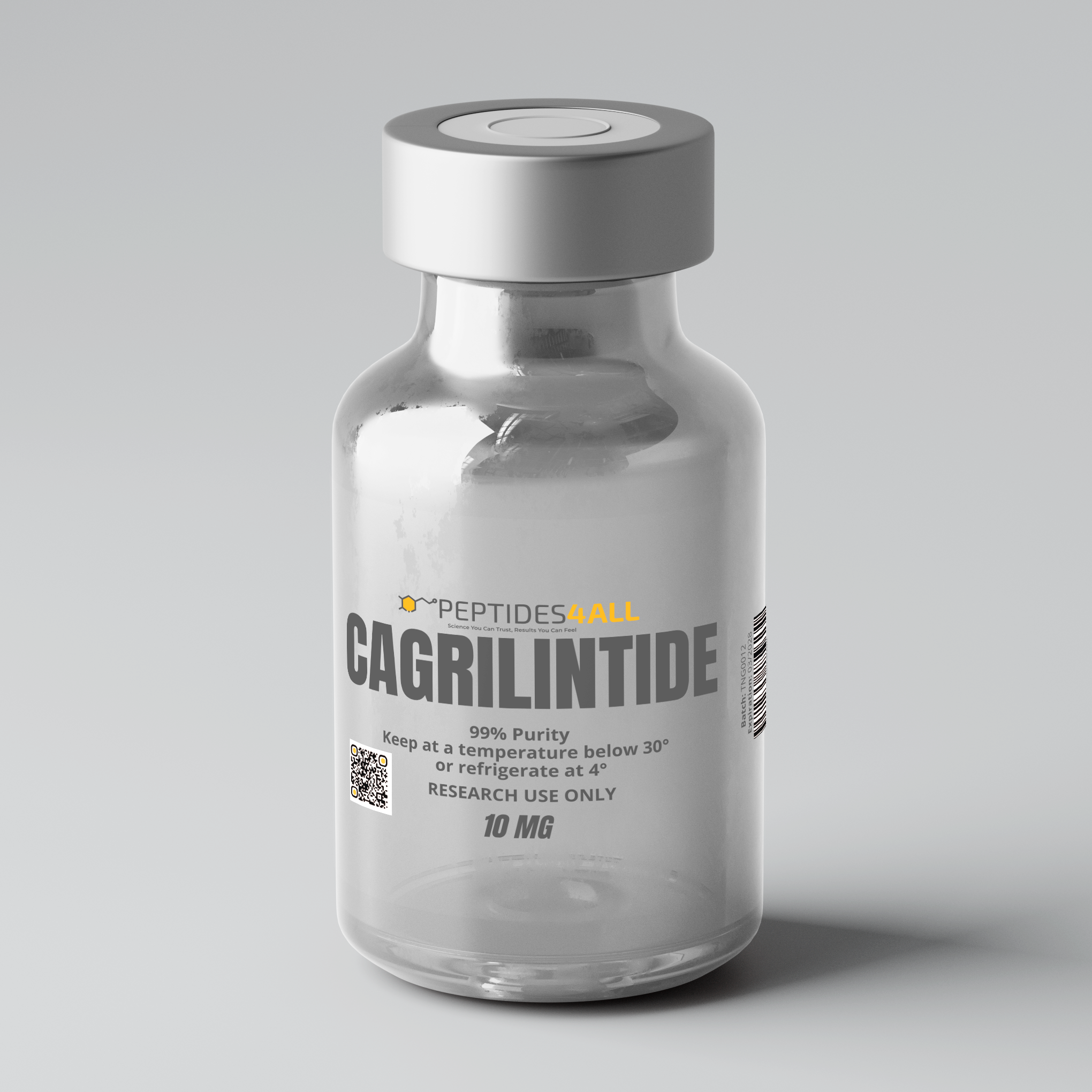PEPTIDES4ALL Cagrilintide – Long-Acting Amylin Analogue for Metabolic Research
PEPTIDES4ALL Cagrilintide represents a next-generation research peptide designed to advance the scientific understanding of energy balance, appetite regulation, and glucose metabolism. As a long-acting analogue of the pancreatic hormone amylin, Cagrilintide has been engineered with enhanced receptor affinity and metabolic stability, extending its duration of action far beyond that of native amylin.
Through selective binding to amylin receptor subtypes (AMY1R, AMY2R, and AMY3R), Cagrilintide mimics the natural physiological roles of amylin—slowing gastric emptying, enhancing satiety signals, and reducing caloric intake. These properties make it an exceptional model for preclinical investigations into mechanisms of obesity, metabolic syndrome, and glycemic control.PubMed+2American Chemical Society Publications+2
Recent research highlights its synergistic potential when combined with GLP-1 receptor agonists such as Semaglutide, producing superior effects on body-weight reduction and metabolic efficiency. Structural biology studies, including advanced cryo-electron microscopy (cryo-EM) analyses, have provided valuable insight into its distinct receptor interactions and prolonged pharmacological behavior, reinforcing its role as a powerful tool for modern endocrine and metabolic research. The New England Journal of Medicine
In structural biology, recent cryo-EM studies reveal that cagrilintide binds with an “amylin-like mode” to both amylin and calcitonin receptors, with distinct receptor conformational dynamics that may underlie its pharmacologic profiles. Nature
Scientific Evidence & Research Findings
Cagrilintide acts on amylin receptor subtypes (AMY1R, AMY2R, AMY3R), exhibiting a prolonged half-life and enhanced receptor stability compared to native amylin. By slowing gastric emptying, enhancing satiety, and reducing food intake, it provides a unique model for studying appetite control and metabolic homeostasis (J. Med. Chem., 2021, PMC study on AMY1R/AMY3R ).
Preclinical and early-stage clinical studies indicate that Cagrilintide promotes weight reduction and improves glycemic control. When combined with GLP-1 receptor agonists such as Semaglutide, data suggest additive or synergistic effects on body-weight management, making it a valuable dual-pathway model for obesity and diabetes research (Diabetes Obesity & Metabolism, The New England Journal of Medicine).
Recent cryo-electron microscopy (cryo-EM) studies have further characterized Cagrilintide’s “amylin-like” receptor-binding mode, revealing distinct conformational dynamics within amylin and calcitonin receptors that may underlie its prolonged pharmacological action and unique signaling properties (Nature Communications; PubMed structural analysis).
Key Research Benefits & Applications
-
Advanced Appetite & Satiety Regulation: Acts as a potent amylin receptor agonist across AMY1R, AMY2R, and AMY3R subtypes, reducing caloric intake, delaying gastric emptying, and enhancing satiety signals, providing a robust model for appetite and feeding behavior research.
-
Long-Acting Metabolic Stability: Engineered for extended plasma half-life and sustained receptor engagement, enabling prolonged activity and consistent pharmacodynamic effects compared to native amylin.
-
Weight Reduction & Metabolic Balance: Demonstrates dose-dependent weight loss and improved glycemic control in preclinical and human studies, supporting exploration in obesity, insulin resistance, and metabolic syndrome.
-
Synergistic Potential with GLP-1 Agonists: When co-administered with GLP-1 receptor agonists (e.g., Semaglutide), produces additive or synergistic outcomes in energy regulation and adiposity reduction—making it ideal for dual-pathway incretin-amylin research.
-
Mechanistic Insight via Structural Biology: Cryo-electron microscopy (cryo-EM) analyses reveal distinct receptor conformational dynamics within amylin and calcitonin receptors, offering new understanding of biased signaling, receptor kinetics, and ligand selectivity.
-
Applications in Endocrine & Metabolic Research: Serves as a cutting-edge model compound for investigating energy expenditure, appetite control, amylin receptor pharmacology, and multi-hormonal weight regulation strategies.
Presentation & Handling
- Form: Supplied as lyophilized peptide in sterile vial.
- Reconstitution: Use bacteriostatic water or 2% procaine; swirl gently (do not shake vigorously).
- Storage: Store at –20 °C, protected from light and moisture. After reconstitution, use according to research protocols and handle under sterile conditions.
Intended Use
For research purposes only. Must be handled in accordance with institutional protocols and ethical guidelines.
